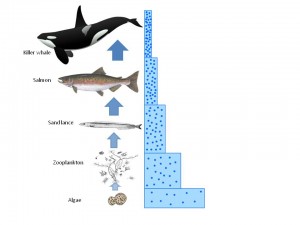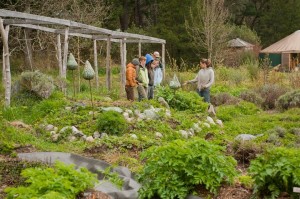Whales and Cars?
“What are the effects of cars on whales?” This week, we were all asked this question by the extremely knowledgeable killer whale researcher Dave Bain. We all sat there, staring blankly and not coming up with any potential impacts. We could think of nothing. However, it turns out cars are one of the top threats to the marine mammals. Everything from oil spills, to abundance of prey, to threats to the whales from alternative energy are influenced by them.
It’s a theme that we’ve been learning a lot about in the past couple weeks. Our terrestrial environment has remarkable
effects on the marine ecosystems. It’s something that isn’t thought of that much, with the exception of direct dumping into the environment and potential contamination of groundwater. But it is a concept that deserves more attention. This terrestrial impact has been the focus of our service projects this year, and rightfully so. Last week, we helped work on the enhancement and restoration of Beaverton Marsh. Over the years, the invasive reed canary grass has taken over the wetland, which has fallen victim to agricultural overuse. The restoration project aims to help restore native species and increase the diversity of the marsh. So for a couple of hours we all sloshed around in the mud and put plant protectors and mulch on plants that had been previously planted. It was hard work, but well worth the effort. Plus, it was a GORGEOUS day, which made it very enjoyable!
Last Friday we spent the day helping out on an organic local farm. We toured the farm and learned
a bit about organic farming on the island. We talked about permaculture, which is a type of agriculture that tries to model natural processes in nature. For example, there is a heavy focus on the use of perennial plants over annual plants (which need to be planted every year). The majority of plants found in the wild are perennials, which have a very stable root system. These long, deep roots absorb nutrients more efficiently, and so generally require less maintenance than annuals, and don’t deplete the topsoil as much. For more information on the use of perennials vs. annuals, check out this article from National Geographic.
Now you might be wondering what all of this really has to do with whales. It turns out, a lot! The three main threats to the southern resident killer whales were listed as being: 1) Prey availability, 2) Vessel noise, and 3) Toxins. The terrestrial environment can have a large effect on both prey availability and toxins. Degradation of the spawning environments of Chinook salmon can limit the returns of the fish back to the ocean. These rivers are easily affected by humans and agriculture. Cattle and other livestock can erode the river and stream banks and the removal of riparian vegetation leads to decreased shelter from predators (provided by shade) and increased temperatures that could rise to undesirable levels for the cold-loving salmon. Agricultural runoff creates an influx of nutrients that can lead to eutrophication and decreased oxygen content in water bodies. Dams create barriers to salmon migration to spawning areas. All of these lead to less fish for the killer whales to eat.
Toxins also pose a huge threat to the killer whales. High on the trophic pyramid, the killer whales suffer from the bioaccumulation of chemicals (see diagram at right). High levels of DDT, PCBs, and PBDEs have been found in killer whales. These are all organic chemicals that don’t breakdown well, leading to relatively high levels in the mari ne environment, even for the now illegal DDT. Indeed, many pesticides are a problem. Kwiaht in 2008 found that pyrethroid pesticide levels in the San Juan County waters averaged 1-2 parts per billion, with much higher levels in some areas. Levels of 1 part per billion are known to be toxic to salmonids. Surfactants, which are chemicals used to mix water and oil, are present in nearly every man-made product. The Friday Harbor Aquarium found lethal levels of surfactants in the surrounding water.
ne environment, even for the now illegal DDT. Indeed, many pesticides are a problem. Kwiaht in 2008 found that pyrethroid pesticide levels in the San Juan County waters averaged 1-2 parts per billion, with much higher levels in some areas. Levels of 1 part per billion are known to be toxic to salmonids. Surfactants, which are chemicals used to mix water and oil, are present in nearly every man-made product. The Friday Harbor Aquarium found lethal levels of surfactants in the surrounding water.
All of these toxins come from the terrestrial environment. It is important to be conscious of what we’re pouring down the drain or dumping outside. The San Juan Islands were heavily glaciated in the last ice age, which has resulted in very thin soils in many areas. Soil typically helps to filter groundwater. This decreased filtration can lead to increased runoff of chemicals to the marine environment. It’s important to be conscious of what we’re pouring down the drain or dumping outside. Try to minimize the amount of chemicals poured down the drain. Take care of your septic system to help prevent leakage. Restoration projects help bring back native species which help balance the ecosystem. Sustainable agricultural processes help reduce the runoff of toxic pesticides and other chemicals. So be cautious, be aware, and help protect these iconic animals!





 Twitter
Twitter LinkedIn
LinkedIn Facebook
Facebook